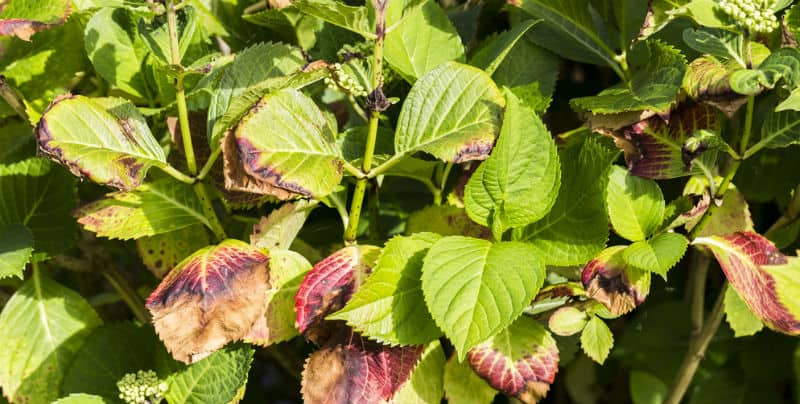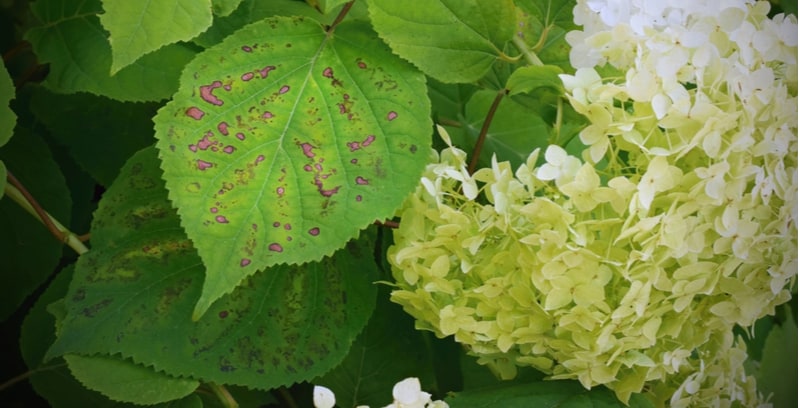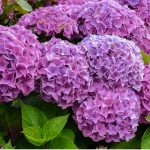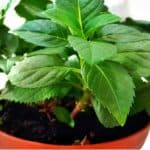Last updated on April 18th, 2022
Our site is reader supported, this means we may earn a small commission from Amazon and other affiliates when you buy through links on our site.
Hydrangeas are very popular for the large pom pom shaped flowers and the collection of colours they provide you with, however, on occasions, you may find that the leaves are turning yellow and this can be frustrating if you don’t understand the cause. There are plenty of reasons why leaves might turn yellow, but rest assured, there are also plenty of solutions.
Natural Yellow Colouring
In some cases, the leaves naturally turn yellow. There are a few varieties of Hydrangeas that produce yellow leaves as they get older. One of the most common is called Lemon Daddy. If you purchase one of these varieties be aware of the fact that as the leaves get older they will naturally turn yellow and this usually happens in the autumn.
Leaf Scorch

If you notice that the leaves are wilting and then turning yellow it could be a sign of leaf scorch. This happens if the Hydrangea is getting too much sun, particularly in the afternoon. You can make sure you water your plant a little bit longer than you normally would and keep the soil moist during the warmer weather. You can also add some insulation to encourage water retention by applying a few centimetres of mulch around the base of the plant.
Leaf Spot

If you have had particularly rainy weather, the cause might be leaf spot. Leaf spot turns the leaves yellow once it is advanced. You might, at first, notice, smaller purple spots during the height of summer. If left unchecked, by the end of the summer the leaves will turn yellow.
You can prevent the disease from spreading throughout your plant by removing any of the yellow leaves that have fallen and making sure you water your Hydrangea at the base and not on top of the leaves because watering from above can cause the bacteria to spread. If things continue to persist for multiple seasons you might want to purchase a pre-mixed fungicide and treat the issue that way.
Iron Chlorosis
If you are growing a big leaf variety, it could be an issue of iron chlorosis. This is basically a nutrient deficiency and means your Hydrangea needs more iron.
If you see the leaves are turning yellow, but they still have green veins, it is likely an iron deficiency. You can mix some sequestered iron into the soil, following instructions on the packaging and it will remediate the issues. With this in mind, make sure you apply the iron to the base of the Hydrangea and not on the leaves.
Should the problem persist, you might want to check the pH levels in your soil. This is because a high pH level could exacerbate the issue, however, you can reduce the pH levels quite easily, with the simple addition of pine bark mulch around the plant.
Nitrogen Deficiency
Another potential cause of yellow leaves is nitrogen deficiency. This is something you often see in older leaves and the best way to rectify this is to add ammonium sulphate to your soil. If you scatter ammonium sulphate to the base of your Hydrangea and water it, the levels of nitrogen in the soil will increase and help return the leaves back to their normal colour.
- Fast-acting nitrogen vegetable feed
- Cures leaf yellowing
- Ready-to-use granules
- Promotes lush, green, healthy foliage
- Encourages strong leaf growth
Overall, there are many causes of yellowing leaves, but with each, there is also a solution.
Last update on 2025-04-02 / Affiliate links / Images from Amazon Product Advertising API




